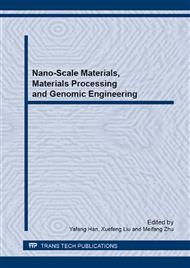[1]
E. Frank, F. Hermanutz, M.R. Buchmeiser, Carbon Fibers: Precursors, Manufacturing, and Properties, Macromol. Mater. Eng. 6(2012) 493-501.
DOI: 10.1002/mame.201100406
Google Scholar
[2]
A.G. Dumanlı, A.H. Windle, Carbon fibres from cellulosic precursors: a review, J. Mater. Sci. 10(2012) 4236-4250.
DOI: 10.1007/s10853-011-6081-8
Google Scholar
[3]
M. MInus, S. Kumar, The processing, properties, and structure of carbon fibers, JOM. 2(2005) 52-58.
Google Scholar
[4]
FuHe,JianguoZhao,RuneWang, Viscose-Based Carbon Fibre, New Chemical Materials. 01(1999) 3-10.
Google Scholar
[5]
Q. Wu, N. Pan, K. Deng, D. Pan, Thermogravimetry–mass spectrometry on the pyrolysis process of Lyocell fibers with and without catalyst, Carbohydr. Polym. 2(2008) 222-228.
DOI: 10.1016/j.carbpol.2007.08.005
Google Scholar
[6]
M. Tang, R. Bacon, Carbonization of cellulose fibers—I. Low temperature pyrolysis, Carbon. 3(1964) 211-220.
DOI: 10.1016/0008-6223(64)90035-1
Google Scholar
[7]
I. Karacan, T. Soy, Enhancement of oxidative stabilization of viscose rayon fibers impregnated with ammonium sulfate prior to carbonization and activation steps, J. Appl. Polym. Sci. 2(2013) 1239-1249.
DOI: 10.1002/app.38496
Google Scholar
[8]
Y.A. Kim, K. Fujisawa, H. Muramatsu, T. Hayashi, M. Endo, T. Fujimori, K. Kaneko, M. Terrones, J. Behrends, A. Eckmann, Raman spectroscopy of boron-doped single-layer graphene, ACS nano. 7(2012) 6293-6300.
DOI: 10.1021/nn301728j
Google Scholar
[9]
L.G. Cançado, A. Jorio, E.H.M. Ferreira, F. Stavale, C.A. Achete, R.B. Capaz, M.V.O. Moutinho, A. Lombardo, T.S. Kulmala, A.C. Ferrari, Quantifying Defects in Graphene via Raman Spectroscopy at Different Excitation Energies, Nano letters. 8(2011) 3190-3196.
DOI: 10.1021/nl201432g
Google Scholar
[10]
A. Paipetis, Stress Induced Changes in the Raman Spectrum of Carbon Nanostructures and Their Composites, In: Carbon Nanotube Enhanced Aerospace Composite Materials, Springer, 2013, pp.185-217.
DOI: 10.1007/978-94-007-4246-8_6
Google Scholar
[11]
J.H. Wiley, R.H. Atalla, Band assignments in the Raman spectra of celluloses, Carbohydr. Res. 1987 113-129.
DOI: 10.1016/0008-6215(87)80306-3
Google Scholar
[12]
K. Kong, L. Deng, I.A. Kinloch, R.J. Young, S.J. Eichhorn, Production of carbon fibres from a pyrolysed and graphitised liquid crystalline cellulose fibre precursor, J. Mater. Sci. 14(2012) 1-9.
DOI: 10.1007/s10853-012-6426-y
Google Scholar
[13]
T. Kobayashi, K. Sumiya, Y. Fukuba, M. Fujie, T. Takahagi, K. Tashiro, Structural heterogeneity and stress distribution in carbon fiber monofilament as revealed by synchrotron micro-beam X-ray scattering and micro-Raman spectral measurements, Carbon. 5(2011) 1646-1652.
DOI: 10.1016/j.carbon.2010.12.048
Google Scholar
[14]
K. Kavkler, A. Demšar, Examination of cellulose textile fibres in historical objects by micro-Raman spectroscopy, Spectrochim. Acta. Part A. 2(2011) 740-746.
DOI: 10.1016/j.saa.2010.12.006
Google Scholar
[15]
K. Schenzel, S. Fischer, NIR FT Raman spectroscopy–a rapid analytical tool for detecting the transformation of cellulose polymorphs, Cellulose. 1(2001) 49-57.
Google Scholar
[16]
H. Edwards, D. Farwell, D. Webster, FT Raman microscopy of untreated natural plant fibres, Spectrochim. Acta. Part A. 13(1997) 2383-2392.
DOI: 10.1016/s1386-1425(97)00178-9
Google Scholar
[17]
L.M. Proniewicz, C. Paluszkiewicz, A. Wesełucha-Birczyńska, H. Majcherczyk, A. Barański, A. Konieczna, FT-IR and FT-Raman study of hydrothermally degradated cellulose, J. Mol. Struct. 1(2001) 163-169.
DOI: 10.1016/s0022-2860(01)00706-2
Google Scholar
[18]
S. Vollebregt, R. Ishihara, F.D. Tichelaar, Y. Hou, C.I.M. Beenakker, Influence of the growth temperature on the first and second-order Raman band ratios and widths of carbon nanotubes and fibers, Carbon. 10(2012) 3542-3554.
DOI: 10.1016/j.carbon.2012.03.026
Google Scholar
[19]
G. Katagiri, H. Ishida, A. Ishitani, Raman spectra of graphite edge planes, Carbon. 4(1988) 565-571.
DOI: 10.1016/0008-6223(88)90157-1
Google Scholar
[20]
Y. Wang, D.C. Alsmeyer, R.L. McCreery, Raman spectroscopy of carbon materials: structural basis of observed spectra, Chem. Mater. 5(1990) 557-563.
DOI: 10.1021/cm00011a018
Google Scholar
[21]
A. Sadezky, H. Muckenhuber, H. Grothe, R. Niessner, U. Pöschl, Raman microspectroscopy of soot and related carbonaceous materials: Spectral analysis and structural information, Carbon. 8(2005) 1731-1742.
DOI: 10.1016/j.carbon.2005.02.018
Google Scholar
[22]
E. Ebner, D. Burow, J. Panke, A. Börger, A. Feldhoff, P. Atanassova, J. Valenciano, M. Wark, E. Rühl, Carbon blacks for lead-acid batteries in micro-hybrid applications – Studied by transmission electron microscopy and Raman spectroscopy, J. Power Sources. 2013) 554-560.
DOI: 10.1016/j.jpowsour.2012.08.089
Google Scholar


